




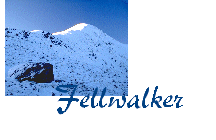
At first
sight Landscape should be the easiest form of photography, no elusive wildlife,
tricky studio lighting, or temperamental models. Just a nice mountain or
tree that never runs away or turns up late. Unfortunately or perhaps fortunately
there is the small issue of the light. If photography is "painting with
light" then landscape is that in spades. We have to be in the perfect position
in the appropriate weather at the best time of day. When, by luck or judgment,
this all comes together it is imperative to have trained our eye to recognise
the moment.
I have found that a little study has resulted in a appreciable improvement to the photographs I make and the following books have helped me get what I hope are decent results. (Those stocked by Amazon.co.uk are denoted by a "price" button which can be clicked through to check delivery and price).
"Landscape in Britain" photographed by Charlie Waite, narrative by Adam Nicolson ( ISBN 907516 55 6 )
160 pages of text and images (colour and black and white, 6x6 medium format) from all over Britain with a discussion of the nature of the landscape, how it came to be as it is and our place in it.
 "The
Making Of Landscape Photographs" Charlie Waite.
"The
Making Of Landscape Photographs" Charlie Waite.![]()
150 of
his own colour images (Spain, UK, France and Italy) are examined in retrospect
to establish why they worked and are used to illustrate the techniques
of landscape photography. Each photograph has a narrative, a technical
panel (lens focal length etc.) and a "point to watch".I found this book
an excellent checklist of techniques, some I thought obvious (don't ignore
winter!), some I had forgotten about (warm up filters) and some gave me
food for thought (stepping towards the distance).
On patterns
in the landscape:-
"Points
to watch - There is only one point to watch: make it whole, exclude
the excludable and think only of the pattern, not of the place. You must
not try and be fair to the landscape. That is not the point. Ruthless excision
of the boring can be the only principle. Think of the picture frame as
a stage on which you are arranging the players. What happens outside is
irrelevant."
On a sense
of scale in a image of St.Brides Bay:-
 "It
is impossible to get any sense of scale in this picture (not
shown here ) unless you realise that the tiny
blip of a figure on the edge of the water is a human being......that figure
alone, a thing so out of scale with everything that surrounds him, reveals
the bigness of the place and the size of the marine processes that are
shaping it........One lesson emerges: scale can be understood only in relative
terms. Something big will only look big when set against something small."
"It
is impossible to get any sense of scale in this picture (not
shown here ) unless you realise that the tiny
blip of a figure on the edge of the water is a human being......that figure
alone, a thing so out of scale with everything that surrounds him, reveals
the bigness of the place and the size of the marine processes that are
shaping it........One lesson emerges: scale can be understood only in relative
terms. Something big will only look big when set against something small."
(I have immodestly
illustrated this point with my own photo and paid the price by seeing my
own work next to that of Franco Fontana!)
 "Photographing
Places" Semenzato ISBN 0 7126 0201 1
"Photographing
Places" Semenzato ISBN 0 7126 0201 1
I think the title of this book has lost something in the translation from Italian. It is however an excellent little volume packed with first rate images (350) from the best photographers* to illustrate the points discussed, which include high altitude photography and photographing snow and ice. The book is in four sections - Perceiving the landscape (including a comparison of landscape painting and photography) - Problems and how to overcome them - The language of shapes and a final section on the urban landscape.
*including Franco Fontana, Ansel Adams and Ernst Haas.
I think this is one of the best collections of landscape photos around. And there is no better way of learning about the subject than by looking at good images. Features the work of eight photographers :-
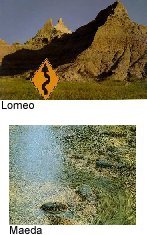 Franco
Fontana, Yuan Li, Angelo Lomeo, Shinzo Maeda, Harald Sund, Sonja Bullaty,
John Chang McCurdy and Steven C. Wilson.
Franco
Fontana, Yuan Li, Angelo Lomeo, Shinzo Maeda, Harald Sund, Sonja Bullaty,
John Chang McCurdy and Steven C. Wilson.
It is difficult to pick out images from amoungst such a good selection but Lomeo's witty series of foreground roadsigns echoing the mountain landscape beyond stand out as does Shinzo Maeda's "Flowing Leaves" which captures the winding flow of a river's currents by a 1 second exposure of pine needles on its surface.
 Franco
Fontana's semi abstract images demand a mention. "Lagoon at Comacchio"
(left) in particular probably reaches the limit* for this type of photograph.
Taken with a 20mm lens the image is reduced to a minimalist graduation
of blue sky and its reflection in still water, bisected by a pencil line
of horizon.
Franco
Fontana's semi abstract images demand a mention. "Lagoon at Comacchio"
(left) in particular probably reaches the limit* for this type of photograph.
Taken with a 20mm lens the image is reduced to a minimalist graduation
of blue sky and its reflection in still water, bisected by a pencil line
of horizon.
* or goes
beyond it?
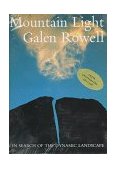 Galen
Rowell, killed recently in an air crash, was probably one of the best known
mountain photographers. "Mountain light" explores techniques of landscape
photography through his own photos. The chapters are "Magic Hour", "Still
Vision", "Backlight", "Mountain Vision", "Soft Light","Integrated Vision","Sundown
to Sunrise","Selective Vision","Artist's Light",Extraordinary Vision","Figures
in a Landscape","Operative Vision","Light against LIght","Dynamic Vision"
and "Unexpected Convergence". I was impressed when on page one I found
a piece of thought provoking advice, to spend more time looking at my bad
shots to establish exactly what was wrong with each one.
Galen
Rowell, killed recently in an air crash, was probably one of the best known
mountain photographers. "Mountain light" explores techniques of landscape
photography through his own photos. The chapters are "Magic Hour", "Still
Vision", "Backlight", "Mountain Vision", "Soft Light","Integrated Vision","Sundown
to Sunrise","Selective Vision","Artist's Light",Extraordinary Vision","Figures
in a Landscape","Operative Vision","Light against LIght","Dynamic Vision"
and "Unexpected Convergence". I was impressed when on page one I found
a piece of thought provoking advice, to spend more time looking at my bad
shots to establish exactly what was wrong with each one.
Chapter one deals with the edges of the day and begins with a statement which (in my opinion) is very important for a landscape photographer - "The most interesting parts of the natural world are the edges, places where oceans meet land, meadow meets forest, timberline touches the heights. These geographical edges excite scientists in much the same way that edges of light fascinate me.......my favourite way to photograph a geographical edge is to make it converge with a visual edge of light that will underscore the difference between the two zones".
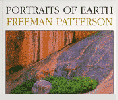
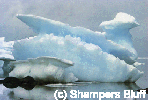
"Portraits
of Earth"![]() Freeman Patterson 180 pages large format.
Freeman Patterson 180 pages large format.
Images
from Canada, the Arctic, the Namib desert, the Caribbean etc. Stunning
photographs with brief descriptive texts with some longer texts under titles
"Earth","Portraits", "Earth and Design","Desert Portraits","The Forest",
"Waterscapes" and "Portraits of sky and mind".

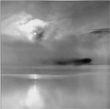 Lovers
of monochrome may like to look at David Herrod's moody images of the Lakes
- "Waters of Cumbria" (Creative Monochrome) - www.davidherrod.co.uk
(excellent foreword by Colin Welland)
Lovers
of monochrome may like to look at David Herrod's moody images of the Lakes
- "Waters of Cumbria" (Creative Monochrome) - www.davidherrod.co.uk
(excellent foreword by Colin Welland)The Digital darkroom


Photoshop is the definitive image manipulation software for scanned and digital photos. The Elements version is aimed at the amateur and CS2 at the professional.
I made a comparison of Photoshop 7 (earlier version of CS2) which I will call "PS7" and Elements 5 (for PC), which I will call "PSE" for any shortcomings that might effect the reasonably serious amateur. Elements has a quick mode and full edit mode. Quick mode appears to be provided for the casual user and causes useful options like custom rotate to be greyed out.
Perspective crop.
(Used to correct keystone effect when camera was tilted) Unlike PS7, in PSE there is no perspective option in the crop function but "Image | transform | perspective" allows perspective adjustment evenly for the whole image. The function is repeated in the excellent "Camera Distortions" menu which also has easy to use "vignette" and "level horizon" tools.
Unsharp
mask
(used
for precise sharpening) Present in both.
Colour
and similar adjustments
Emphasis
is on auto functions in PSE. However most of the manual functions of PS7
are present:- Hue/saturation, levels, shadow/highlight, brightness/contrast.
The "Colour balance" of PS7 appears to be absent. There is however a "remove
colour cast" by selection of true grey by eyedropper and a skin tone
control.
Curves
Curves
differs from PS7. It is not possible to directly manipulate the graph,
adjustments are achieved by four slider controls under advanced options,
(the standard option being to offer thumbnails of a series of predetermined
adjustments). There is no colour channel option in PSE curves. However
a curves plug-in is
available.
File
formats and 16 bit files
PSE
could not directly load my Pentax raw files. This is no great problem as
Pentax provide a utility with the camera that can convert PEF to TIFF or
JPG. ("Irfanview" is a shareware package that can batch convert Pentax
raw files to TIFF)
16
bit TIFF files could be read into PSE, but only a few tools could work
on that format. CS2 can both import RAW files and work on 16 bit TIFFs.
Unsurprisingly I found PSE easy to learn and use and only awkward in removal of colour casts. PS7 and it successor offer many advanced features of use to those already familiar with the areas I have addressed above.
Some images on this page were found on the web without copyright notice and may or may not be copyright. They are used here for review purposes only